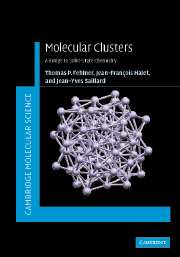Book contents
- Frontmatter
- Contents
- Preface
- 1 Introduction
- 2 Main-group clusters: geometric and electronic structure
- 3 Transition-metal clusters: geometric and electronic structure
- 4 Isolobal relationships between main-group and transition-metal fragments. Connections to organometallic chemistry
- 5 Main-group–transition-metal clusters
- 6 Transition to the solid state
- 7 From molecules to extended solids
- 8 Inter-conversion of clusters and solid-state materials
- Appendix: Fundamental concepts: a concise review
- Problem Answers
- References
- Index
Preface
Published online by Cambridge University Press: 19 February 2010
- Frontmatter
- Contents
- Preface
- 1 Introduction
- 2 Main-group clusters: geometric and electronic structure
- 3 Transition-metal clusters: geometric and electronic structure
- 4 Isolobal relationships between main-group and transition-metal fragments. Connections to organometallic chemistry
- 5 Main-group–transition-metal clusters
- 6 Transition to the solid state
- 7 From molecules to extended solids
- 8 Inter-conversion of clusters and solid-state materials
- Appendix: Fundamental concepts: a concise review
- Problem Answers
- References
- Index
Summary
Who, what, where, why, when and how – the elementary prescription for a news squib is also appropriate for a preface.
Who? The book is intended primarily as a text for advanced undergraduates and graduate students. It can also serve the needs of research workers in the wide area of nanochemistry, as molecular clusters and extended solid-state materials constitute the structural “bookends” of nanoparticles: species that are not large enough to be treated with solid-state concepts but too large to follow the simple rules of molecular clusters. Those interested in a wide-ranging introduction to models of electronic structure applicable to delocalized, three-dimensional systems will also find it useful.
What? This text circumscribes a non-traditional area of inorganic chemistry. The focus is on a class of compound that exhibits cluster bonding. Emphasis is on connections between the problems of small molecular clusters, where the vast majority of atoms are found at the surface, to large crystals, where most atoms are found in the bulk. A review of bonding in molecular compounds (Chapter 1) is followed by the fundamentals of cluster bonding in p-block clusters (Chapter 2) and transition-metal clusters (Chapter 3). After making connections with organometallic chemistry (Chapter 4), mixed p–d-block clusters are developed (Chapter 5). A bonding model for periodic extended structures (Chapter 6) is developed in the style of Chapter 1. Chapter 7 then illustrates some of the similarities and differences between the bonding of clusters and related solid-state structures.
- Type
- Chapter
- Information
- Molecular ClustersA Bridge to Solid-State Chemistry, pp. ix - xiiPublisher: Cambridge University PressPrint publication year: 2007



